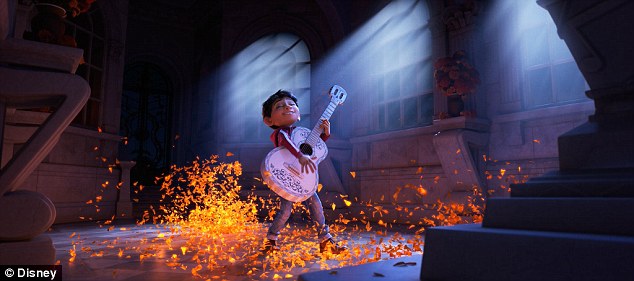Disney-Pixar released its first feature film “Toy Story” in 1995. Since then, audiences have reunited fish families, befriended the monsters in our closets and got our kicks on Route 66. On March 15, Disney-Pixar released a teaser-trailer for yet another feature film, “Coco,” coming to theaters this November.
The trailer left plenty to the imagination, but the visuals and bits of script it offered left fans, many Latino, both excited and uneasy about what’s to come.
It begins with 12-year-old Miguel entering a hideout and holding a guitar. The small space is donned with flowers, photos of the late musician Ernesto De la Cruz and white candles, resembling an altar for the Mexican holiday Día de los Muertos (Day of the Dead). He plays a VHS tape titled “Best of De la Cruz” and watches his idol who says, “The rest of the world may follow the rules, but I must follow my heart.”
Little information about the plot was revealed by the franchise, but this quote set the stage for what viewers can expect for the film’s theme. Ever since Miguel’s great-great-grandfather left his wife behind to become a musician, music was banned in the family. Miguel discovers a similar passion for music in secret and, with his animal sidekick Dante, ends up in the colorful and magical Land of the Dead.
While the fantasy worlds Disney created for us as children elicit deep emotional connections, the franchise we know today has done a much better job at extending inclusiveness toward Latino and Hispanic minorities.
“Growing up, I remember identifying with Hispanic shows such as Dora the Explorer and some others, but never with Disney because they hadn’t expanded to Hispanic cultures yet,” said freshman broadcast journalism major Sophia Espinosa. “It affected me in a way that I didn’t appreciate my own culture because I never saw Disney appreciate it in films. Kids today have a much better sense of diversity and purpose because of the multitude of people portrayed in films.”
Modern characters like Sophia the First and Elena of Avalor have paved a way in Latino and Hispanic representation thus far by incorporating a mix of many Spanish-speaking cultures into the shows. However, the characters’ ambiguity and Eurocentric features, such as Sophia’s blue eyes and light skin, have also been called into question.
“I don’t think [Sophia the First] is for Latinos because she’s more Spaniard,” said sophomore psychology and creative writing major Patricia Santana. “Elena of Avalor is cute. I wish the first Latina princess had her own movie but … I think little girls will still be able to enjoy that.”
Santana also mentioned when Disney-Pixar tried to trademark the term “Día de los Muertos” in 2013.
“Their intent is kind of sketchy to me because there’s [a difference between] generally wanting to represent a culture and wanting to profit off of it,” Santana said. “I love Disney … but they are certainly guilty of missteps.”
With this in mind, Coco has a lot to live up to for excited and skeptical fans alike.







